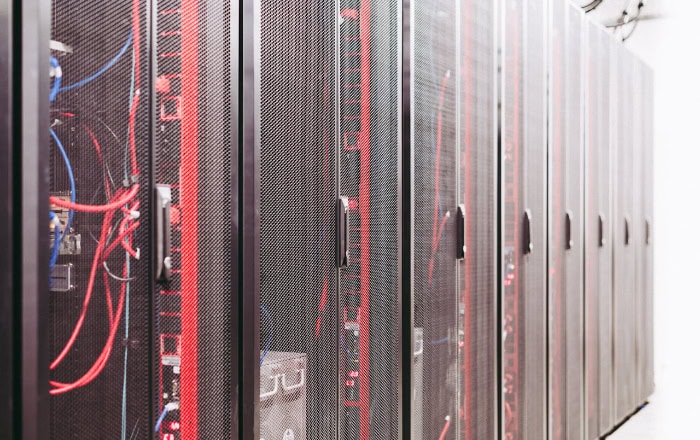How and Where Information on the Internet Is Stored

Have you ever wondered where the countless petabytes of data that make up the internet are physically stored? From the millions of websites and online services to the endless stream of user-generated content, the internet is a vast repository of information.
But all this data doesn't just float around in a nebulous “cloud.” It resides in a complex network of data centers, storage devices, and content delivery systems that work tirelessly behind the scenes to ensure the internet remains accessible and functional 24/7.
The Backbone of Internet Storage
At the foundation of the internet's vast storage capabilities lie data centers—the physical facilities that house the servers, storage devices, and networking equipment that power the digital world. These data centers are the central hubs where the majority of internet data is stored, processed, and distributed.
Without these critical infrastructure components, the internet as we know it would cease to function.
What Are Data Centers?
A data center is a dedicated space that organizations use to house their IT infrastructure, including servers, storage systems, networking equipment, and other associated components. These facilities are designed to provide a secure, reliable, and efficient environment for storing and processing large amounts of data.
Data centers are equipped with redundant power supplies, cooling systems, and security measures to ensure the continuous operation and protection of the equipment within.
Types of Data Centers
There are several types of data centers, each serving different purposes and catering to specific organizational needs:
- Cloud Data Centers: These data centers are operated by cloud service providers and offer virtualized computing resources, including storage, over the internet. Cloud data centers enable businesses to store and access their data remotely without the need for on-premises infrastructure.
- Enterprise Data Centers: Many large organizations maintain their own private data centers to store and process their data. These facilities are owned and operated by the company itself and provide greater control over data security and infrastructure management.
- Colocation Data Centers: Colocation facilities provide space, power, and cooling for organizations to house their own servers and equipment. Companies can rent space within these data centers, benefiting from the shared infrastructure and resources while maintaining control over their hardware.
Major Data Center Locations Worldwide
Data centers are strategically located around the world to provide optimal coverage and minimize latency for users accessing internet services. Some of the major data center hubs include:
- United States: The U.S. is home to many large data center clusters, particularly in regions such as Northern Virginia, Silicon Valley, Dallas, and Chicago. These locations offer abundant power, connectivity, and proximity to major internet exchange points.
- Europe: European data centers are concentrated in countries like the United Kingdom, Germany, France, and the Netherlands. These locations provide coverage for the European market and are subject to EU data protection regulations.
- Asia-Pacific: The Asia-Pacific region has seen significant growth in data center infrastructure, with hubs in countries like Singapore, Hong Kong, Japan, and Australia. These locations serve the rapidly expanding digital economies of Asia and provide low-latency access to users in the region.
The distribution of data centers across multiple geographic locations ensures redundancy, load balancing, and improved performance for internet services.
Cloud Storage and Service Providers

In recent years, cloud storage has emerged as a popular and convenient way for individuals and businesses to store and access their data. Cloud storage involves storing data on remote servers hosted by third-party providers, rather than on local devices or on-premises infrastructure.
This model offers scalability, flexibility, and accessibility, making it an attractive option for many users.
Definition of Cloud Storage
Cloud storage refers to a data storage model in which digital data is stored on remote servers accessed through the internet. These servers are maintained and operated by cloud service providers, who ensure the security, availability, and durability of the stored data.
Users can upload, access, and manage their files and documents from anywhere with an internet connection, using various devices such as computers, smartphones, or tablets.
Major Cloud Service Providers
Several major tech companies have established themselves as leading cloud service providers, offering a wide range of storage solutions and computing resources. Some of the most prominent players in the cloud storage market include:
- Amazon Web Services (AWS): AWS is the largest cloud service provider, offering a comprehensive suite of storage services, including Amazon S3 (Simple Storage Service) for object storage, Amazon EBS (Elastic Block Store) for block-level storage, and Amazon Glacier for long-term archival storage.
- Google Cloud Platform (GCP): Google Cloud offers various storage options, such as Google Cloud Storage for object storage, Persistent Disks for block storage, and Cloud Filestore for file storage. GCP also provides powerful data analytics and machine learning capabilities.
- Microsoft Azure: Azure, Microsoft's cloud computing platform, offers Azure Blob Storage for unstructured data, Azure Files for file shares, and Azure Disk Storage for virtual machine disks. Azure integrates seamlessly with other Microsoft services and tools.
These cloud service providers, along with others like IBM Cloud, Oracle Cloud, and Alibaba Cloud, compete to offer reliable, scalable, and cost-effective storage solutions to meet the diverse needs of businesses and individuals.
How Cloud Storage Works
Cloud storage operates on a client-server model, where the user's device (the client) communicates with the cloud service provider's servers over the internet. When a user uploads a file to the cloud, the data is transmitted to the provider's data centers, where it is stored on multiple servers for redundancy and reliability.
The user can then access their files from any device with an internet connection by logging into their cloud storage account.
Behind the scenes, cloud storage providers employ various technologies and strategies to ensure data integrity, security, and availability:
- Data Redundancy: Cloud providers store multiple copies of user data across different servers and data centers to protect against hardware failures and ensure data availability.
- Encryption: Data is typically encrypted both in transit (when being uploaded or downloaded) and at rest (when stored on the cloud servers) to protect against unauthorized access.
- Scalability: Cloud storage services can automatically scale storage capacity up or down based on user needs, allowing for flexibility and cost optimization.
- Data Synchronization: Many cloud storage services offer file synchronization, allowing users to keep their files up to date across multiple devices automatically.
Storage Technologies and Methods

The internet's vast data storage requirements are met through a combination of various storage technologies and methods. These technologies have evolved over time to provide faster, more reliable, and more cost-effective solutions for storing and accessing digital information.
From traditional hard disk drives to cutting-edge innovations like DNA storage, the landscape of storage technologies continues to advance.
Hard Disk Drives (HDDs) vs. Solid-State Drives (SSDs)
Two of the most common storage devices used in data centers are hard disk drives (HDDs) and solid-state drives (SSDs). HDDs have been the primary storage medium for decades, utilizing spinning disks and read/write heads to store and retrieve data magnetically.
They offer large storage capacities at relatively low costs, making them suitable for bulk data storage.
On the other hand, SSDs have gained popularity in recent years due to their superior performance and durability. SSDs use flash memory to store data electronically, without any moving parts.
This enables faster data access speeds, lower latency, and improved reliability compared to HDDs. However, SSDs are generally more expensive per gigabyte of storage than HDDs.
In modern data centers, a combination of HDDs and SSDs is often used to balance performance, capacity, and cost. SSDs are employed for applications that require fast data access, such as database servers and caching, while HDDs are used for bulk storage and less performance-critical tasks.
Tape Storage for Archival Purposes
Despite the dominance of HDDs and SSDs, tape storage remains a viable option for long-term data archiving. Magnetic tape libraries offer cost-effective, high-capacity storage for data that is accessed infrequently but needs to be retained for extended periods.
Tape storage is known for its durability, with a lifespan that can exceed 30 years when properly maintained.
Tape storage is commonly used for backup and disaster recovery purposes, as well as for storing large volumes of historical data, such as scientific research, medical records, and media archives. While tape storage has slower access times compared to HDDs and SSDs, it provides a reliable and energy-efficient solution for long-term data preservation.
Emerging Storage Technologies
As the demand for data storage continues to grow exponentially, researchers and technology companies are exploring innovative storage solutions that could transform the way we store and access information in the future. Two notable examples of emerging storage technologies are DNA storage and quantum storage.
- DNA Storage: DNA, the building block of life, has the potential to become a highly dense and durable storage medium. By encoding digital data into synthetic DNA sequences, researchers have demonstrated the ability to store massive amounts of information in a tiny space. DNA storage offers the promise of long-term data preservation, with a theoretical storage density far exceeding that of current technologies.
- Quantum Storage: Quantum computing, which harnesses the principles of quantum mechanics, could enable the development of ultra-secure and high-capacity storage systems. Quantum storage leverages the properties of quantum bits (qubits) to store and process information in ways that are not possible with classical computing. While still in the early stages of research, quantum storage has the potential to provide unbreakable encryption and exponential increases in storage capacity.
Data Distribution and Access

Storing data is only one part of the equation when it comes to delivering content to internet users. Equally important is the efficient distribution and access of that data, ensuring that it reaches users quickly and reliably, regardless of their location.
Several technologies and strategies are employed to optimize data delivery and enhance the user experience.
Content Delivery Networks (CDNs)
Content Delivery Networks (CDNs) play a crucial role in the efficient distribution of internet content. A CDN is a geographically distributed network of servers that work together to deliver content to users based on their location.
By caching content on servers closer to the users, CDNs reduce the distance that data has to travel, resulting in faster load times and improved performance.
When a user requests content from a website or application that uses a CDN, the request is routed to the nearest server in the CDN network. This server then delivers the cached content to the user, minimizing latency and network congestion.
CDNs are particularly effective for serving static content, such as images, videos, and scripts, which can be cached and delivered from multiple locations.
Popular CDN providers include Akamai, Cloudflare, and Amazon CloudFront. These services offer global networks of edge servers, advanced caching mechanisms, and intelligent routing to optimize content delivery for businesses of all sizes.
Edge Computing and Local Caching
Edge computing is an emerging paradigm that brings computation and data storage closer to the sources of data, such as end-user devices or IoT sensors. By processing data at the edge of the network, rather than in centralized data centers, edge computing enables faster response times, reduced bandwidth requirements, and improved data privacy.
In the context of internet data storage and delivery, edge computing involves the use of local caching and processing at the network edge. This can include caching frequently accessed content on edge servers, performing data aggregation and filtering at the edge, and executing application logic closer to the users.
Edge computing complements traditional cloud computing by distributing processing and storage across a network of edge nodes. This approach is particularly beneficial for applications that require low latency, such as real-time video streaming, gaming, and industrial automation.
Load Balancing and Traffic Management
Effective data distribution and access also rely on efficient load balancing and traffic management techniques. Load balancing involves distributing incoming network traffic across multiple servers or resources to optimize performance, ensure high availability, and prevent overloading of individual components.
Load balancers act as intermediaries between clients and servers, directing traffic to the most appropriate server based on factors such as server capacity, current load, and geographic proximity. They can also perform health checks on servers to ensure that only healthy and responsive servers receive traffic.
Traffic management techniques, such as DNS load balancing and global server load balancing (GSLB), further enhance the distribution of traffic across multiple data centers and regions. These techniques take into account factors like network latency, server health, and user location to route traffic to the optimal destination.
Data Security, Privacy, and Management

As the internet continues to store and process vast amounts of data, ensuring the security, privacy, and proper management of that data becomes paramount. With the increasing reliance on digital services and the growing concerns over data breaches and unauthorized access, implementing robust security measures and adhering to data protection regulations are critical aspects of internet data storage.
Encryption and Security Measures
Encryption is one of the primary tools used to protect data stored on the internet. Encryption involves converting plain text data into a coded format that can only be deciphered with the appropriate decryption key.
This ensures that even if unauthorized individuals gain access to the data, they cannot read or make sense of it without the necessary decryption information.
Data encryption is applied at various levels, including:
- Data in Transit: Encryption is used to secure data as it travels across networks, such as when users access websites through HTTPS (Hypertext Transfer Protocol Secure). Transport Layer Security (TLS) and its predecessor, Secure Sockets Layer (SSL), are commonly used protocols for encrypting data in transit.
- Data at Rest: Encryption is also applied to data stored on servers and storage devices. This includes encrypting individual files, folders, or entire disks to protect against unauthorized access, even if the physical storage media is compromised.
In addition to encryption, other security measures are employed to safeguard internet data:
- Access Controls: Strict access controls, such as user authentication, role-based access, and multi-factor authentication, ensure that only authorized individuals can access sensitive data.
- Network Security: Firewalls, intrusion detection systems (IDS), and virtual private networks (VPNs) help protect data by monitoring and controlling network traffic, detecting and preventing unauthorized access attempts.
- Regular Security Audits: Organizations conduct regular security audits and vulnerability assessments to identify and address potential weaknesses in their data storage and processing systems.
Data Redundancy and Backup Strategies
Data redundancy and backup strategies are essential for ensuring the availability and durability of internet data. Redundancy involves creating multiple copies of data and storing them across different servers, storage devices, or even geographic locations.
This mitigates the risk of data loss due to hardware failures, natural disasters, or other disruptions.
Common data redundancy techniques include:
- RAID (Redundant Array of Independent Disks): RAID configurations distribute data across multiple disks, providing fault tolerance and improved performance. Different RAID levels offer varying degrees of redundancy and performance characteristics.
- Replication: Data replication involves creating identical copies of data and storing them on separate servers or storage systems. This ensures that if one copy becomes unavailable, the data can still be accessed from another replica.
- Geo-redundancy: Storing data in geographically dispersed locations helps protect against regional outages or disasters. By replicating data across multiple data centers in different geographic regions, organizations can ensure high availability and disaster recovery capabilities.
Regular data backups are also crucial for protecting against data loss. Backups involve creating periodic copies of data and storing them on separate storage media or in remote locations.
In the event of data corruption, accidental deletion, or ransomware attacks, backups allow for the restoration of data to a previous state.
Data Retention Policies and Regulations
Data retention policies and regulations govern how long organizations must retain certain types of data and when they can delete or dispose of it. These policies and regulations vary depending on the industry, jurisdiction, and the nature of the data involved.
Some examples of data retention regulations include:
- GDPR (General Data Protection Regulation): The European Union's GDPR sets strict requirements for the collection, storage, and processing of personal data. It mandates that personal data should only be retained for as long as necessary to fulfill the purpose for which it was collected.
- HIPAA (Health Insurance Portability and Accountability Act): HIPAA, a U.S. regulation, sets standards for the protection of personal health information (PHI). It requires healthcare organizations to implement appropriate safeguards and retain PHI for specified periods.
- SOX (Sarbanes-Oxley Act): SOX, a U.S. financial regulation, requires publicly traded companies to retain certain financial records and electronic communications for a minimum of five years.
Organizations must develop and implement data retention policies that align with applicable regulations and industry best practices. These policies should define the types of data to be retained, the retention periods, and the procedures for secure data disposal when the retention period expires.
Effective data management also involves regular data audits, classification, and governance practices to ensure that data is properly categorized, stored, and handled throughout its lifecycle.
Conclusion
The vast and intricate world of internet data storage is a testament to human ingenuity and the relentless pursuit of technological advancement. From the sprawling data centers that form the backbone of the internet to the cutting-edge storage technologies that promise to reshape our digital future, the ecosystem of internet data storage is both complex and fascinating.
Throughout this article, we have explored the various components that make up this ecosystem, including the critical role of data centers, the rise of cloud storage and major service providers, the evolution of storage technologies like HDDs and SSDs, the importance of data distribution and access through CDNs and edge computing, and the crucial aspects of data security, privacy, and management.
As the amount of data generated and stored on the internet continues to grow at an unprecedented rate, the challenges of managing and storing this data become increasingly complex. However, with ongoing advancements in storage technologies, data management practices, and security measures, we can be confident that the internet will continue to serve as a reliable and efficient repository of information for years to come.
The future of internet data storage is undoubtedly exciting, with emerging technologies like DNA storage and quantum storage holding the potential to redefine the way we store and access data. As these technologies mature and become more widely adopted, we can expect to see even more innovative solutions to the challenges of storing and managing the ever-increasing amounts of data that power our digital lives.
In the end, understanding the complex ecosystem of internet data storage is not only a matter of technical knowledge but also a recognition of the incredible feats of engineering, innovation, and collaboration that make our connected world possible. As we continue to push the boundaries of what is possible with data storage and management, we can look forward to a future where the vast wealth of human knowledge and creativity is preserved and accessible for generations to come.


